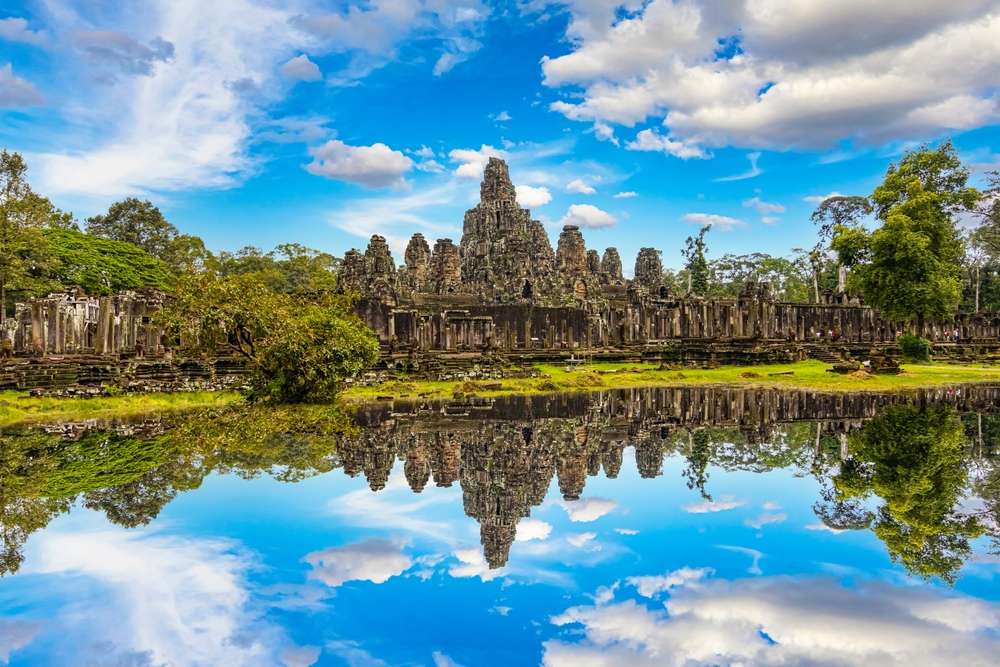Cambodia, a country steeped in history, culture, and natural beauty, offers travelers a unique blend of ancient temples, bustling cities, serene landscapes, and warm hospitality. While the world-famous Angkor Wat draws millions of visitors each year, Cambodia has much more to offer beyond its iconic landmarks. From hidden temples lost in the jungle to tranquil coastal towns, Cambodia is a land of discovery waiting to be explored. In this article, we will take you on a journey across Cambodia’s most iconic and hidden gems, revealing the diverse experiences that make this Southeast Asian nation a must-visit destination.
The Majestic Angkor Wat: A Testament to Ancient Glory
No journey through Cambodia would be complete without a visit to Angkor Wat, the crown jewel of the Khmer Empire and the largest religious monument in the world. Located near the city of Siem Reap, Angkor Wat is a symbol of Cambodia’s rich cultural heritage and architectural prowess. Built in the early 12th century by King Suryavarman II, this sprawling temple complex is dedicated to the Hindu god Vishnu and is renowned for its intricate bas-reliefs, towering spires, and symmetrical design.
As you wander through the temple’s corridors, you’ll be transported back in time, marveling at the stories of gods, kings, and battles carved into the walls. The sunrise at Angkor Wat is a sight to behold, as the first rays of light illuminate the temple’s silhouette, casting a golden glow over the surrounding moats and forests. Despite its popularity, Angkor Wat retains an air of mystery and grandeur that leaves a lasting impression on all who visit.
CAMBODIA VISA FOR BOLIVIAN CITIZENS
Exploring the Hidden Temples of Angkor: Ta Prohm and Preah Khan
While Angkor Wat is undoubtedly the most famous temple in Cambodia, the Angkor Archaeological Park is home to many other remarkable sites that are worth exploring. Ta Prohm, often referred to as the “Tomb Raider Temple” due to its appearance in the famous movie, is a hauntingly beautiful temple engulfed by the roots of massive banyan and kapok trees. The intertwining roots and crumbling stone structures create an otherworldly atmosphere, making Ta Prohm a favorite among photographers and adventurers alike.
Another hidden gem within the Angkor complex is Preah Khan, a sprawling temple complex built by King Jayavarman VII in the 12th century. Unlike the more tourist-heavy sites, Preah Khan is relatively quiet, allowing visitors to explore its maze-like corridors and courtyards in peace. The temple’s name, which means “Sacred Sword,” hints at its historical significance as a center of learning and military prowess. As you explore Preah Khan, you’ll discover a mix of Buddhist and Hindu elements, reflecting the syncretic nature of Khmer culture.
Phnom Penh: The Vibrant Capital with a Complex History
Phnom Penh, Cambodia’s bustling capital, offers a stark contrast to the ancient temples of Angkor. Situated at the confluence of the Mekong and Tonle Sap rivers, Phnom Penh is a city that has seen both the heights of grandeur and the depths of tragedy. Today, it is a vibrant metropolis where tradition meets modernity, offering visitors a glimpse into Cambodia’s past and present.
The Royal Palace, with its golden spires and manicured gardens, is a must-visit attraction in Phnom Penh. The palace complex is home to the Silver Pagoda, which houses a collection of priceless Buddhist artifacts, including a life-sized Buddha statue made of solid gold and adorned with over 9,000 diamonds. A visit to the Royal Palace provides insight into the country’s monarchy and its enduring cultural significance.
However, Phnom Penh is also a place of reflection, as it is home to the Tuol Sleng Genocide Museum and the Killing Fields of Choeung Ek. These sites serve as somber reminders of Cambodia’s dark history under the Khmer Rouge regime. Visiting these memorials is a powerful experience that deepens one’s understanding of the resilience of the Cambodian people and the importance of remembering the past to build a better future.
Battambang: Cambodia’s Artistic and Cultural Heart
For those seeking a more off-the-beaten-path experience, Battambang offers a charming blend of French colonial architecture, artistic flair, and rural beauty. Located in western Cambodia, Battambang is known for its laid-back atmosphere, making it an ideal destination for travelers looking to immerse themselves in local culture.
The city is a hub for Cambodia’s burgeoning art scene, with numerous galleries, workshops, and cafes showcasing the work of local artists. The Phare Ponleu Selpak Circus, a social enterprise that trains disadvantaged youth in the performing arts, is a highlight of Battambang. Attending a performance is a unique way to experience traditional Cambodian storytelling through acrobatics, music, and dance.
Outside the city, the countryside of Battambang is dotted with ancient temples, rice paddies, and quaint villages. The bamboo train, or “norry,” is a fun and unconventional way to explore the rural landscape. This makeshift railcar, powered by a small engine, takes visitors on a scenic ride through the countryside, offering glimpses of daily life in rural Cambodia.
The Tranquil Beaches of Kep and Kampot
While Cambodia is often associated with its temples and history, the country also boasts beautiful coastal destinations that are perfect for relaxation and adventure. Kep, a small seaside town near the Vietnamese border, is famous for its delicious seafood, particularly the locally caught crab. The town’s Crab Market is a must-visit for food lovers, where you can enjoy fresh crab cooked with Kampot pepper, another local specialty.
Kep is also home to Kep National Park, a lush, forested area with hiking trails that offer panoramic views of the coastline and nearby islands. The park is a haven for nature lovers, with opportunities to spot wildlife such as macaques, and hornbills, and monitor lizards.
Just a short drive from Kep is Kampot, a charming riverside town known for its colonial architecture, pepper plantations, and relaxed vibe. Kampot’s scenic riverfront is the perfect place to unwind, with a variety of cafes, restaurants, and guesthouses offering stunning views of the river and surrounding mountains. The town is also a gateway to Bokor National Park, where you can explore the eerie ruins of a French colonial hill station, hike through dense forests, and enjoy cool mountain air.
CAMBODIA VISA FOR BOSNIA AND HERZEGOVINA CITIZENS
Koh Rong and Koh Rong Samloem: Pristine Island Paradises
For those seeking a tropical escape, the islands of Koh Rong and Koh Rong Samloem offer pristine beaches, crystal-clear waters, and a laid-back island vibe. Located off the coast of Sihanoukville, these islands are perfect for snorkeling, diving, and simply relaxing by the beach.
Koh Rong, the largest of the two islands, is known for its vibrant nightlife, while Koh Rong Samloem offers a more tranquil and secluded experience. The islands’ natural beauty, combined with their relatively undeveloped status, makes them ideal destinations for travelers looking to disconnect from the hustle and bustle of daily life.
Conclusion: Cambodia’s Endless Discoveries
Traveling through Cambodia is a journey filled with endless discoveries. From the awe-inspiring temples of Angkor to the vibrant streets of Phnom Penh, from the artistic charm of Battambang to the tranquil beaches of Kep and Kampot, Cambodia offers a rich tapestry of experiences that cater to all types of travelers. As you explore this captivating country, you’ll not only witness its iconic landmarks but also uncover hidden gems that reveal the depth and diversity of Cambodia’s cultural and natural heritage. Whether you’re a history buff, an adventure seeker, or simply looking for a peaceful retreat, Cambodia promises a journey that will leave you with lasting memories and a deeper appreciation for its beauty and resilience.
Read more: How India’s Cultural Diversity Shapes Its Business Opportunities










